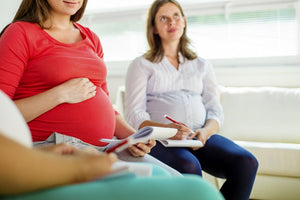Find out with Physiotherapist, yoga teacher + 2 x mum Rosie.
Our understanding of exercise in pregnancy + postpartum has come a long way in the recent years, and we are much more likely to treat the “normal” pregnancy as a normal physiological process – not a disability.
I am constantly underwhelmed at the information I find online, and in the fitness “influencer” space, as well as mis-information that abounds on social media. So what are the key things you actually need to know about exercising in pregnancy?
We always recommend seeking clearance from your Medical caregiver to begin or maintain an exercise regime upon falling pregnant, as each woman’s circumstances require individual consideration. However, in the presence of a routine, healthy pregnancy staying active does wonders for both your own, and your baby’s physical, emotional and intellectual wellbeing.
The WHO (World Health Organisation) recommends a woman between the ages of 18-64 participate in 300 mins a week of moderate intensity exercise each week, and this doesn’t change in the presence of a normal, routine pregnancy. We used to say “don’t start anything new” in pregnancy with regards to exercise, but we now recommend that a previously inactive woman actually START moving, albeit in a sensible and gradual fashion, and build up gradually over the course of the pregnancy to eventually meet the minimum recommendations. This might be as simple as a 10 min walk daily, that builds gradually, indoor/ stationary cycling, prenatal pilates or yoga.
We also know that staying active in pregnancy + the postpartum period has many benefits for both mother + baby. According to research conducted + reviewed by Dr James Clapp + Catherine Cram (2012), regular activity throughout pregnancy through to term:
- reduces incidence + severity of back pain
- can reduce labour length by up to 1/3
- reduces the severity of peri + postnatal anxiety + depression
- improves both yours + your babies physiological response to stress
- babies of regularly active mothers tend to have a higher IQ score at 12 months old
For the already active woman, by and large, she can continue to do what she normally does in the first trimester, with particular note to:
- avoid contact or dangerous activities (cycling, contact sports, extreme sports)
- exercise in a cool environment to avoid overheating, for e.g avoid hot yoga + hot outdoor climates
- be well rested, well fed and well hydrated
- be kind to yourself, especially if you have or have had morning sickness and vomiting, its ok in this instance to take some time off until you feel well enough – but just get back on the horse when you can!
- exercise caution with high impact activity; whilst running is generally OK if you are used to running regularly, keep the intensity moderate and reduce the duration if you are used to running long distances – you are now training to keep fit, not to make any PB’s!
- if you are used to resistance training, you can continue to do resistance exercises in the gym, but think about reducing the load to no more than 60% of your usual weight, to prioritise safety, and stay away from any abdominal compression work/ traditional ab work even from early on. Using a TRX trainer can be a great way to use body weight for strength, and working with a prenatal certified fitness trainer will also help you to feel confident in your programming.
The main considerations for those regularly lifting weights prior to falling pregnant, and wanting to continue are:
- avoiding compression of your abdominal region – crunches and anything of this nature are out, in place of more whole body “functional” core exercises (think pelvic floor activation with all movements)
- exhale on exertion, with emphasis on pelvic floor lift, and gentle activation of your deeper abdominals, with the feeling of “hugging your baby”- navel to spine direction
- stomach lying exercises will need to be phased out by early in the second trimester,
- reduce your range / depth to a manageable range of movement where you feel you have control,
- reduce your weight to max 50-60% of your usual load (this will decrease over the course of your pregnancy, as you gain body weight, this serves as a form of additional resistance itself! You can increase the reps to still give yourself some challenge, if this is of concern.
Keep in mind, the hormone relaxin peaks in your body between 12-16 weeks, so an emphasis on controlled range of motion and reducing the depth of movement where appropriate is important to note.
As you move into the second trimester, you may want to further modify the intensity of your exercise. For example continuing to run as your baby grows, poses significant load on your pelvic floor, combined with the hormonal effects which make it a bit tougher on your pelvis than usual. Being an avid runner, I usually walk/ jog up until about 16-17 weeks, and then this gives way to a stationary exercise bike, walking or the occasional swim, for my cardiovascular training.
Prenatal yoga, pilates, light weights and body weight exercises, stationary cycling and swimming are my pick in this period. Having a strong core + glutes can set you up for an easier pregnancy as your belly expands + places increased pressure on your joints, so making some yoga or pilates a priority every week is a great place to start.
In the 3rd trimester, we still want to maintain activity as much as we can, but you might be slowing down the intensity, and starting to have your “training” give way to “preparation for birth.” Doing some yoga or pilates, daily walking and staying active with your other expecting friends, family or animals will also help your waning energy levels. You want to balance exercise with rest, as you get your energy reserves topped up prior to the arrival of your bub. Having said this, if you have pregnancy insomnia (which I’ve had throughout all 3 pregnancies, worse in the first + last trimesters) making sure you get some activity in early in the day will help you to sleep later that evening.
What about intensity?
Most GP’s have historically recommend you keep your heart rate below 140bpm, though we now recommend that you chose an intensity that is based on your Rate of Perceived Effort, or RPE. A maximum effort level of 12-16/ 20 on the Borg Scale (moderate-moderately hard) is what we recommend, as a specific heart rate number or range can mean different things for different people – I am cruising and not out of breath at 140bpm, but a sedentary woman starting exercise in pregnancy would likely be over exerting herself at this level.
In summary, we want to treat a normal pregnancy like the normal physiological process that it is, and work to maintain healthy habits and set ourselves up for a pain-free and hormone happy pregnancy + motherhood.
About the author:
Rosie is a passionate movement enthusiast, and has worked in the health and fitness space since the age of 17, with qualifications + experience in massage, personal training, pilates, physiotherapy, yoga + more under her belt over the span of 17 years since then. Since becoming a mother, her interests + education focus has shifted to working with women in the childbearing years of their lives, and has recently taken this to a new level, through her collection of physio + motherhood inspired active + support wear garments - Lenny Rose Active.
Our Products
-

01. Guide to a Healthy Pregnancy
$55 -

02. Positive Birthing Course
$55 -

03. Infant Feeding Guide
$55 -

04. Baby Sleep Guide - First 12 Months
$55 -

05. Toddler Parenting Course 1 - 3 Years
$55
-
 When to Start Antenatal Classes?
When to Start Antenatal Classes?
Becoming a parent is an incredible milestone, but it comes with a host of changes that can be daunting, especially for first time parents. Antenatal classes are all about offering expectant parents the education they need to make informed decisions, look after their bodies and care for their newborn babies. While you probably already have a long list of things you need to accomplish during your pregnancy, it’s a good idea to make time to attend antenatal classes.
-
 Development Milestones 4-8 Months
Development Milestones 4-8 Months
As they reach the middle of their first year, you'll start to see bigger leaps in their growth and ability!
In this article, we’re going to discuss your baby’s developmental milestones between 4-8 months, and what you can expect along the way.





 When to Start Antenatal Classes?
When to Start Antenatal Classes?
 Development Milestones 4-8 Months
Development Milestones 4-8 Months








